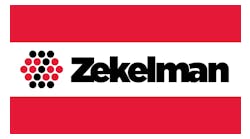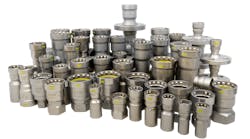BY ROBERT P. MADER of CONTRACTOR’s staff
CHICAGO — The Palmer House Hilton needed to replace its cooling tower and called on industrial and commercial HVAC firm Team Mechanical Inc. to install the tower on the roof of the 24-floor hotel. TMI worked with manufacturers rep Maddock Industries to purchase the new $250,000, 112,000-lb. Marley Cooling Technologies cooling tower and get it delivered in less than eight weeks. That was the easy part. The hard part — closing down Chicago’s Loop to lift tons of equipment via helicopter onto the roof of the 24-floor hotel — had just begun.
The project was awarded in mid-February, said Bob Doessel, vice president/construction operations, Team Mechanical. The contractor had to quickly turn around submittals, contracts and insurance certificates so that it could get the cooling tower on order with Marley Cooling Technologies.
The tower had to be replaced because the original Binks cooling tower had been installed in 1961. It was inefficient, required too much maintenance and it was difficult to get spare parts for it.
The piping connections had to be re-engineered because the old tower and the new tower were so different. Wayne Krys, project engineer for TMI, drew the piping layout and engineered the flows and pipe sizing, which were approved by Palmer House Director of Property Operations Marty Gerbac and chief engineer Mike Meehan.
The mains are 16-in. Schedule 40 steel pipe and branch piping for the suction and return to the tower are 10 in. The piping was reconnected to the existing condenser water pumps.
Doessel ordered an accessory from Marley called a bottom inlet connection, which consists of four 10-in. PVC connections that allowed Doessel’s crew to pipe the cooling tower from the bottom rather than having to run piping up to the top.
“It saved well over 200 hours of labor,” Doessel told CONTRACTOR.
There was plenty to do in Chicago while the cooling tower was being fabricated.
Team Mechanical subcontracted with Nickelson Industrial Service to demolish and remove the old cooling tower, which it did by taking “bundles and bundles and bundles” of disassembled redwood down the hotel’s elevators over 312 weeks.
TMI then went to work modifying the existing support steel. The Binks tower weighed the same as the Marley cooling tower, but the Binks tower was 100 ft. by 20 ft. while the new tower is 50 ft. by 20 ft., concentrating all the weight in half the footprint.
The new tower was delivered the third week in March to the warehouse of trucker and rigger USMM (formerly United States Machinery Movers) in north suburban Skokie, Ill. Doessel’s crew then had to coordinate with Helicopter Transport Service to keep the lifts at less than 8,500 lb. The contractor disassembled the hand railings, fan motors, fan shrouds and interior walking platforms and skid them so they could be flown up separately.
Then lifts were scheduled for April 10-11, Easter weekend, because it would require closing State and Monroe streets in the heart of downtown. That required permits from the city and coordination with the Chicago Police Department.
Lifting this type of equipment is an intricate sequence of events that took four days of coordination between TMI and Helicopter Transport Service. Each load was planned and numbered because of weight and fuel problems.
The city has closed Meigs Field airport on the lakefront, so the helicopter had to refuel at Midway Airport, adding another 25-40 minutes for each trip. Moreover, helicopters have not been allowed to land in the city since 9/11.
The firms worked out a sequence of lifts so that light loads were lifted first, when the helicopter was full of fuel, and the heavy loads were lifted later when the aircraft had burned fuel and weighed less. The helicopter refueled eight times over the two days.
USMM drove the tower and its components to Chicago’s Loop on 12 flatbeds. It took 21 lifts to bring all the components onto the roof.
Doessel said it was an incredible experience (and an adrenaline rush) rigging lifts amid the noise and wind from a helicopter 50 ft. off the pavement in between skyscrapers. TMI had a ground control crew of 20 on the scene, Helicopter Transport Service had 10 of its own, and 12 police officers controlled access to the area.
TMI had 10 working days to get the cooling tower running, Doessel said. He had an eight-man crew doing the installation and piping because that was all the space would allow.
TMI bought Yaskawa variable frequency drives for the fan motors from Maddock Industries and had them installed by Continental Electric Construction Co. TMI and Continental coordinated with Systems Associates, Bowling Green, Ohio, the preferred controls contractor for Hilton.

